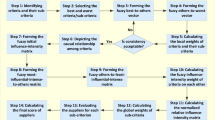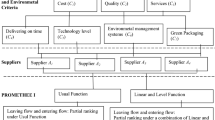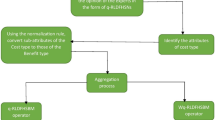Abstract
One of the challenging and complicate processes in supply chain management is to select best supplier from the set of suppliers since they have direct and indirect effects on the core functions of the companies. The supplier selection problem is generally accepted as multi-criteria decision-making (MCDM) since it includes conflict criteria which include uncertain and ambiguous data. Therefore, fuzzy set and its extensions such as intuitionistic fuzzy set have been integrated with MCDM methods in past two decades as they have great capability to handle uncertainty. In this study, hybrid method based on intuitionistic fuzzy preference relation (IFPR) and stochastic multi-criteria acceptability analysis (SMAA-2) is introduced to select best supplier. In the first stage, IFPR is exploited to obtain the criteria weights using the preference of decision-makers (DMs). SMAA-2 method has been utilized to rank alternatives which are rated based on the individual preferences of DMs. The proposed method has been implemented to the selection of the most suitable supplier for effective purchasing the vehicle rental service needed by the armed forces considering the eight criteria. Furthermore, sensitivity analysis has been conducted under eight different scenarios obtained by changing the criteria weights. The results illustrate that IFPR-SMAA-2 method is more capable of discriminating in ranking of alternatives and provides more reliable solutions.



Similar content being viewed by others
Data availability
All data generated or analyzed during this study are included in this published article.
References
Dickson GW (1966) An analysis of vendor selection system and decisions. Journalof Purchasing 2(1):28–41
Weber CA, Current JR, Benton WC (1991) Vendor selection criteria and methods. Eur J Oper Res 50:2–18. https://doi.org/10.1016/0377-2217(91)90033-R
Wilson EJ (1994) The relative importance of supplier selection criteria: a review and update. Int J Purch Mater Manag 30:34–41. https://doi.org/10.1111/j.1745-493X.1994.tb00195.x
Vonderembse MA, Tracey M (1999) The impact of supplier selection criteria and supplier involvement on manufacturing performance. JSupply Chain Manag 35:33–39. https://doi.org/10.1111/j.1745-493X.1999.tb00060.x
Shen CY, Yu KT (2013) Strategic vender selection criteria. Proc Comput Sci 17:350–356. https://doi.org/10.1016/j.procs.2013.05.045
Mardani A, Nilashi M, Zavadskas EK, Awang SR, Zare H, Jamal NM (2018) Decision making methods based on fuzzy aggregation operators: three decades review from 1986 to 2017. Int J Inf Technol Decis Mak 17:391–466. https://doi.org/10.1142/S021962201830001x
Chen CT, Lin CT, Huang SF (2006) A fuzzy approach for supplier evaluation and selection in supply chain management. Int J Prod Econ 102:289–330. https://doi.org/10.1016/j.ijpe.2005.03.009
Haq AN, Kannan G (2006) Fuzzy analytical hierarchy process for evaluating and selecting a vendor in a supply chain model. Int J Adv Manuf Technol 29:826–835. https://doi.org/10.1007/s00170-005-2562-8
Beikkhakhian Y, Javanmardi M, Karbasian M, Khayambashi B (2015) The application of ISM model in evaluating agile suppliers selection criteria and ranking suppliers using fuzzy TOPSIS-AHP methods. Expert Syst Appl 42(15–16):6224–6236. https://doi.org/10.1016/j.eswa.2015.02.035
Chou SY, Chang YH (2008) A decision support system for supplier selection based on a strategy-aligned fuzzy SMART approach. Expert Syst Appl 34:2241–2253. https://doi.org/10.1016/j.eswa.2007.03.001
Rezaei J, Fahim PB, Tavasszy L (2014) Supplier selection in the airline retail industry using a funnel methodology: conjunctive screening method and fuzzy AHP. Expert Syst Appl 41:8165–8179. https://doi.org/10.1016/j.eswa.2014.07.005
Simic D, Kovacevic I, Svircevic V, Simic S (2017) 50 years of fuzzy set theory and models for supplier assessment and selection: a literature review. J Appl Log 24:85–96. https://doi.org/10.1016/j.jal.2016.11.016
Boran FE, Genç S, Kurt M, Akay D (2009) A multi-criteria intuitionistic fuzzy group decision making for supplier selection with TOPSIS method. Expert Syst Appl 36(8):11363–11368
Memari A, Dargi A, Jokar MRA, Ahmad R, Rahim ARA (2019) Sustainable supplier selection: a multi-criteria intuitionistic fuzzy TOPSIS method. J Manuf Syst 50:9–24. https://doi.org/10.1016/j.jmsy.2018.11.002
Yu C, Shao Y, Wang K, Zhang L (2019) A group decision making sustainable supplier selection approach using extended TOPSIS under interval-valued Pythagorean fuzzy environment. Expert Syst Appl 121:1–17. https://doi.org/10.1016/j.eswa.2018.12.010
Li Y, Deng Y (2019) Intuitionistic evidence sets. IEEE Access 7:106417–106426
Liu T, Deng Y, Chan F (2018) Evidential supplier selection based on DEMATEL and game theory. Int J Fuzzy Syst 20:1321–1333. https://doi.org/10.1007/s40815-017-0400-4
Genc S, Boran FE, Akay D, Xu ZH (2010) Interval multiplicative transitivity for consistency issues, missing values and priority weights of interval fuzzy preference relations. Inf Sci 180:4877–4891. https://doi.org/10.1016/j.ins.2010.08.019
Lahdelma R, Salminen P (2010). Stochastic multicriteria acceptability analysis (SMAA). In: Ehrgott, M., Figueira, J., Greco, S. (eds) Trends in multiple criteria decision analysis. International series in operations research and management science, vol 142. Springer, Boston
Durmaz K, Gencer C (2019) A new method in stochastic multi-criteria decision making: swara-smaa-2 and an application. J Aeronaut Space Technol 12–2:129–135
Lahdelma R, Hokkanen J, Salminen P (1998) SMAA—stochastic multiobjective acceptability analysis. Eur J Oper Res 106:137–143
Tervonen T, Figueira JR (2008) A survey on stochastic multicriteria acceptability analysis methods. J Multi-Criteria Decis Anal 15:1–14
Tervonen T (2014) JSMAA: open source software for SMAA computations. Int J Syst Sci 45(1):69–81. https://doi.org/10.1080/00207721.2012.659706
Atanassov KT (1996) An equality between intuitionistic fuzzy sets. Fuzzy Sets Syst 79:257–258. https://doi.org/10.1016/0165-0114(95)00173-5
Zadeh LA (1965) Fuzzy sets. Inf Control 8(338):353. https://doi.org/10.1016/S0019-9958(65)90241-X
Shu MH, Cheng CH, Chang JR (2006) Using intuitionistic fuzzy sets for fault-tree analysis on printed circuit board assembly. Microelectron Reliab 46(12):2139–2148
Bustince H et al (2015) A historical account of types of fuzzy sets and their relationships. IEEE Trans Fuzzy Syst 24:179–194
Xu ZS (2007) Intuitionistic fuzzy aggregation operators. IEEE Trans Fuzzy Syst 15(6):1179–1187
Xu ZS (2007) Intuitionistic preference relations and their application in group decision making. Inf Sci 177(11):2363–2379
Lahdelma R, Salminen P (2001) SMAA-2: stochastic multi criteria acceptability analysis for group decision making. Oper Res 49(3):444–454
Szmidt E, Baldwin JF (2006) Intuitionistic fuzzy set functions, mass assignment theory, possibility theory and histograms. In: 2006 IEEE International conference on fuzzy systems, Vancouver, pp 35–41.
Acknowledgements
The authors are very grateful to the Associate Editor and anonymous referees, for their constructive comments and suggestions that led to an improved version of this paper.
Author information
Authors and Affiliations
Corresponding author
Ethics declarations
Conflict of interest
The authors have no other conflicts of interest to declare that are relevant to the content of this article.
Additional information
Publisher's Note
Springer Nature remains neutral with regard to jurisdictional claims in published maps and institutional affiliations.
Appendix
Appendix
Criteria severity determination form
Please determine the relative importance of the criteria by answering the following questions (“0” is absolutely unimportant according to the second criteria, “0.5” is equally important according to the first and second criteria, “1” is the first criteria is absolutely important according to the second criteria.).
-
1.
The significance level of the Cost criteria according to the Technical Specifications criteria is at least ….. at most….
-
2.
The significance level of the Cost criteria according to the Supplier Reliability criteria is at least ….. at most …..
-
3.
The significance level of the Cost criteria according to the Supportability criteria is at least ……. at most …….
-
4.
The significance level of the Cost criteria according to the Performance History criteria is at least … at most …..
-
5.
The significance level of the Cost criteria according to the Communication System criteria is at least… at most …
-
6.
The significance level of the Cost criteria according to the Management and organization criteria is at least ……. at most …….
-
7.
The significance level of the Cost criteria according to the Delivery criteria is at least …. at most ….
-
8.
The significance level of the Technical Specifications criteria according to the Supplier Reliability criteria is at least …. at most …….
-
9.
The significance level of the Technical Specifications criteria according to the Supportability criteria is at least …. at most …….
-
10.
The significance level of the Technical Specifications criteria according to the Performance History criteria is at least ……. at most …….
-
11.
The significance level of the Technical Specifications criteria according to the Communication System criteria is at least ……. at most …….
-
12.
The significance level of the Technical Specifications criteria according to the Management and organization criteria is at least ……. at most …….
-
13.
The significance level of the Technical Specifications criteria according to the Delivery criteria is at least…. at most …….
-
14.
The significance level of the Supplier Reliability criteria according to the Supportability criteria is at least ……. at most …….
-
15.
The significance level of the Supplier Reliability criteria according to the Performance History criteria is at least … at most…..
-
16.
The significance level of the Supplier Reliability criteria according to the Communication System criteria is at least … at most…….
-
17.
The significance level of the Supplier Reliability criteria according to the Management and organization criteria is at least ……. at most …….
-
18.
The significance level of the Supplier Reliability criteria according to the Delivery criteria is at least ……. at most …….
-
19.
The significance level of the Supportability criteria according to the Performance History criteria is at least …… at most …….
-
20.
The significance level of the Supportability criteria according to the Communication System criteria is at least …at most …….
-
21.
The significance level of the Supportability criteria according to the Management and organization criteria is at least ……. at most …….
-
22.
The significance level of the Supportability criteria according to the Delivery criteria is at least ……. at most …….
-
23.
The significance level of the Performance History criteria according to the Communication System criteria is at least ……. at most …….
-
24.
The significance level of the Performance History criteria according to the Management and organization criteria is at least ……. at most …….
-
25.
The significance level of the Performance History criteria according to the Delivery criteria is at least ……. at most …….
-
26.
The significance level of the Communication System criteria according to the Management and organization criteria is at least ……. at most …….
-
27.
The significance level of the Communication System criteria according to the Delivery criteria is at least ……. at most …….
-
28.
The significance level of the Management and Organization criteria according to the Delivery criteria is at least … at most …
Rights and permissions
Springer Nature or its licensor holds exclusive rights to this article under a publishing agreement with the author(s) or other rightsholder(s); author self-archiving of the accepted manuscript version of this article is solely governed by the terms of such publishing agreement and applicable law.
About this article
Cite this article
İlbaş, A., Gürdere, A. & Boran, F.E. An integrated intuitionistic fuzzy set and stochastic multi-criteria acceptability analysis approach for supplier selection. Neural Comput & Applic 35, 3937–3953 (2023). https://doi.org/10.1007/s00521-022-07919-6
Received:
Accepted:
Published:
Issue Date:
DOI: https://doi.org/10.1007/s00521-022-07919-6




